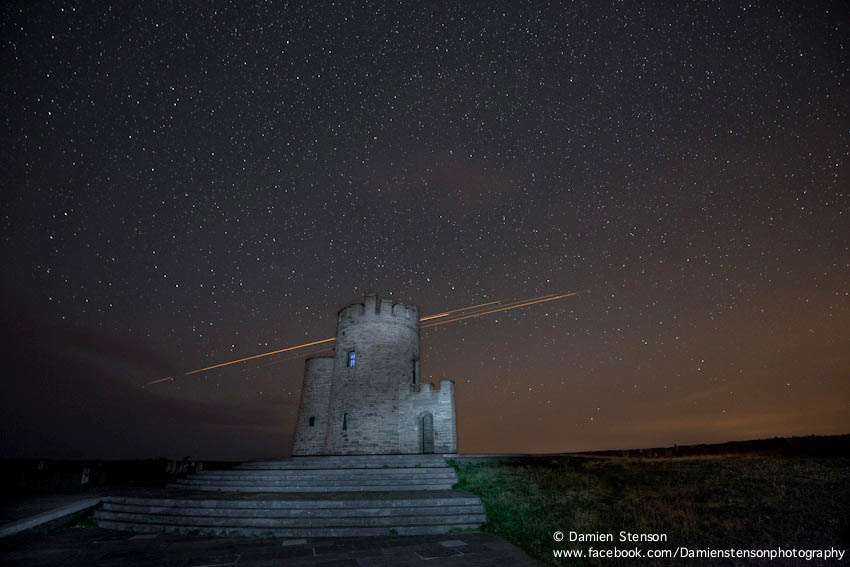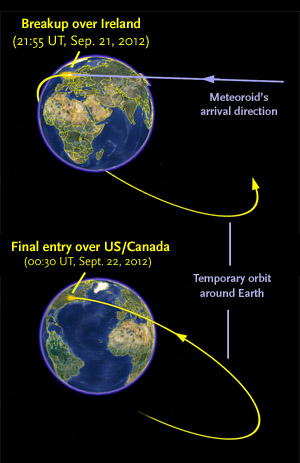
Martin Goff, an officer with the Greater Manchester [England] Police, was making his rounds when he spotted a dazzling meteor at 22:55 p.m. (21:55 Universal Time). "I immediately pulled the van over to better see the fireball," he recounts. "Although not an experienced astronomical observer I was able to log relevant information such as altitude and azimuth relative to the straight road I was on and to trees and streetlights nearby." He estimates it was about as bright as a full moon and remained visible for 35 to 40 seconds, fragmenting for at least the last half of that. "I was just flabbergasted to have seen it!"
He was hardly alone in his amazement. Friday-night crowds were out and about when the bolide appeared, delighting and amazing untold thousands as it broke into dozens of pieces as it glided east to east across the sky. Dirk Ross, who tracks bright meteors and meteorite finds worldwide, logged 564 eyewitness reports from England, Scotland, Ireland, France, Belgium, The Netherlands, and Norway.
A few hours later, Ross received another burst of 126 sightings. But these weren't from Europe - instead, a fireball had appeared over southeastern Canada and the U.S. Northeast. What at first seemed the unlikely arrival of two dramatic bolides in a single night is now known to be something much more historic and scientifically profound.
Mathematician Esko Lyytinen, a member of the Finnish Fireball Working Group of the Ursa Astronomical Association, has analyzed both sets of sightings and concludes that the two events resulted from a single object encountering Earth that night. He believes a large body grazed the upper atmosphere, dipping to an altitude of 33 miles (53 km) over Ireland before escaping back to space. Because it arrived moving at only about 8 miles (13 km) per second, barely above Earth's escape velocity, it lingered for more than a minute as it crossed the sky. (This explains why some witnesses mistook it for reentering spacecraft debris.)

A second analysis of photos and videos of the European event, by aerospace engineer and meteor expert Robert Matson, comes to the same incredible conclusion. Matson's calculations suggest that a big chunk of this Earth-grazer ended up in a temporary orbit with an inclination of about 54° (corresponding to the latitude of its "perigee" over Ireland). Its single looping orbit was highest, about 3,930 miles (6,330 km), somewhere south of Australia, before it boomeranged back to a fiery finale over North America.
There've been widely seen grazers before, though nothing like this. On the evening of October 9, 1992 (also a Friday, by the way), thousands witnessed a bolide that broke apart as it screamed up the East Coast. A piece of it struck a parked car in Peekskill, New York. An even larger meteoroid streaked across the Rocky Mountain sky in broad daylight on August 10, 1972, coming as close as 35 miles (57 km) before returning to interplanetary space. (Its velocity was too fast to become captured.)
In the case of September 21st's double-dipper, high-quality snapshots and videos from astonished onlookers have been key to piecing its story together. For example, Ross has collected 31 videos of the meteoroid passing over Europe.
Photographer Damien Stenson was in the right place at the right time with the right equipment, as he was taking long exposures of the stars and scenery along the Cliffs of Moher on Ireland's west coast. Two of his images are especially diagnostic - and beautiful - in that they clearly show the fragmenting object framed by the Big Dipper and other far-northern stars.
"I spend a lot of time out photographing the Milky Way, meteors, etc.," Stenson comments, "but this was the most impressive sight I've seen yet."



Don't be silly Kelly. The first sentence is way too assumptive. "For the first time ever"? Nah! Reality check: This was most certainly not the first time an object has entered a capture orbit around the Earth, and returned to impact. Nor was Shoemaker-Levy 9 the first time an object has returned to impact Jupiter after a close pass that pulled it apart, and into a capture orbit. The big difference in the two is that here it was a rough ride through the upper atmosphere that broke thing up. At Jupiter, it was gravitational tidal forces that broke up SL-9 into 21 large fragments on its first pass, and which returned to impact.
They only represent the first times we have witnessed such a thing. Statistically speaking we can expect such "boomerang" passes to be a fairly common kind of event.